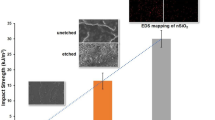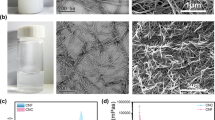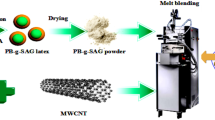Abstract
Some efforts have been made to strengthen the environment friendly natural fiber-reinforced polylactide composite (NFPC), but common approaches impair its ductility. This paper successfully synthesized the rigid-soft core–shell nanoparticles which are feasible to simultaneously improve the strength and toughness of NFPC. The core–shell structure was molecularly designed to act the nano-silica and poly (butyl acrylate) rubber as rigid inner core and soft outer shell, respectively. Furthermore, the devised active functional groups at the end of core–shell filler also interact with polylactide (PLA) matrix to form strong interface. The effect of core–shell nanoparticle on crystalline, thermal and mechanical properties of NFPC was investigated. The results showed that the core–shell nanofiller can facilitate to form the more complete crystalline grain of PLA matrix and the thermal stability improvement of NFPC. More attractively, the addition of the rigid-soft core–shell nanoparticle enhanced the strength and stiffness of NFPC without sacrificing its elongation at break. Finally, the toughness improvement mechanisms and synergistic effect of core–shell nanoparticles were illustrated via field emission scanning electron microscope. It indicates that the micro-cracks, shear band and fibration of the matrix induced by the core–shell filler are the main causes of toughness improvement.













Similar content being viewed by others
References
Pickering KL, Efendy MGA, Le TM (2016) A review of recent developments in natural fiber composites and their mechanical performance. Compos A Appl Sci Manuf 83:98–112
Siengchin S (2017) Editorial corner—a personal view potential use of ‘green’ composites in automotive applications. eXPRESS Polym Lett 11:600
Mavinkere S, Siengchin S (2018) Natural fibers as perspective materials. KMUTNB Int J Appl Sci Technol 11:233
Qu P, Gao Y, Wu G, Zhang L (2010) Nanocomposites of poly (lactic acid) reinforced with cellulose nanofibrils. BioResources 5:1811–1823
Bax B, Müssig J (2008) Impact and tensile properties of PLA/Cordenka and PLA/flax composites. Compos Sci Technol 68:1601–1607
Pan P, Zhu B, Kai W, Serizawa S, Iji M, Inoue Y (2007) Crystallization behavior and mechanical properties of bio-based green composites based on poly (l-lactide) and kenaf fiber. J Appl Polym Sci 105:1511–1520
Nishino T, Hirao K, Kotera M, Nakamae K, Inagaki H (2003) Kenaf reinforced biodegradable composite. Compos Sci Technol 63:1281–1286
Yu T, Ren J, Li S, Yuan H, Li Y (2010) Effect of fiber surface-treatments on the properties of poly (lactic acid)/ramie composites. Compos A Appl Sci Manuf 41:499–505
Goriparthi BK, Suman KNS, Rao NM (2012) Effect of fiber surface treatments on mechanical and abrasive wear performance of polylactide/jute composites. Compos A Appl Sci Manuf 43:1800–1808
Huda MS, Drzal LT, Mohanty AK, Misra M (2008) Effect of fiber surface-treatments on the properties of laminated biocomposites from poly (lactic acid) (PLA) and kenaf fibers. Compos Sci Technol 68:424–432
Kobayashi S, Takada K (2013) Processing of unidirectional hemp fiber reinforced composites with micro-braiding technique. Compos A Appl Sci Manuf 46:173–179
Plackett D, Andersen TL, Pedersen WB, Nielsen L (2003) Biodegradable composites based on l-polylactide and jute fibres. Compos Sci Technol 63:1287–1296
Kumar R, Yakabu MK, Anandjiwala RD (2010) Effect of montmorillonite clay on flax fabric reinforced poly lactic acid composites with amphiphilic additives. Compos A Appl Sci Manuf 41:1620–1627
Thitsartarn W, Fan X, Sun Y, Yeo JCC, Yuan D, He C (2015) Simultaneous enhancement of strength and toughness of epoxy using POSS-Rubber core–shell nanoparticles. Compos Sci Technol 118:63–71
Li Q, Zhang L, Zhang Z, Zhou N, Cheng Z, Zhu X (2010) Air-tolerantly surface-initiated AGET ATRP mediated by iron catalyst from silica nanoparticles. J Polym Sci Part A Polym Chem 48:2006–2015
Ren Y, Zhou G, Cao P (2016) Preparations and properties of a tunable void with shell thickness SiO2@SiO2 core–shell structures via activators generated by electron transfer for atom transfer radical polymerization. Solid State Sci 52:154–162
Zhan X, Yan Y, Zhang Q, Chen F (2014) A novel superhydrophobic hybrid nanocomposite material prepared by surface-initiated AGET ATRP and its anti-icing properties. J Mater Chem A 2:9390–9399
Zafar MT, Maiti SN, Ghosh AK (2016) Effect of surface treatment of jute fibers on the interfacial adhesion in poly (lactic acid)/jute fiber biocomposites. Fibers and Polym 17:266–274
Du Y, Wu T, Yan N, Kortschot MT, Farnood R (2014) Fabrication and characterization of fully biodegradable natural fiber-reinforced poly (lactic acid) composites. Compos B Eng 56:717–723
Masirek R, Kulinski Z, Chionna D, Piorkowska E, Pracella M (2007) Composites of poly (L-lactide) with hemp fibers: morphology and thermal and mechanical properties. J Appl Polym Sci 105:255–268
Lee BH, Kim HS, Lee S, Kim HJ, Dorgan JR (2009) Bio-composites of kenaf fibers in polylactide: role of improved interfacial adhesion in the carding process. Compos Sci Technol 69:2573–2579
Sawpan MA, Pickering KL, Fernyhough A (2011) Effect of fiber treatments on interfacial shear strength of hemp fiber reinforced polylactide and unsaturated polyester composites. Compos A Appl Sci Manuf 42:1189–1196
Zhang J, Duan Y, Sato H, Tsuji H, Noda I, Yan S, Ozaki Y (2005) Crystal modifications and thermal behavior of poly (l-lactic acid) revealed by infrared spectroscopy. Macromolecules 38:8012–8021
Liang JZ, Zhou L, Tang CY, Tsui CP (2013) Crystalline properties of poly (l-lactic acid) composites filled with nanometer calcium carbonate. Compos B Eng 45:1646–1650
Nam JY, Sinha Ray S, Okamoto M (2003) Crystallization behavior and morphology of biodegradable polylactide/layered silicate nanocomposite. Macromolecules 36:7126–7131
Dong Y, Ghataura A, Takagi H, Haroosh HJ, Nakagaito AN, Lau KT (2014) Polylactic acid (PLA) biocomposites reinforced with coir fibres: evaluation of mechanical performance and multifunctional properties. Compos A Appl Sci Manuf 63:76–84
Adeli H, Hussein Sharif Zein S, Huat Tan S, Md Akil H, Latif Ahmad A (2011) Synthesis, characterization and biodegradation of novel poly (l-lactide)/multiwalled carbon nanotube porous scaffolds for tissue engineering applications. Curr Nanosci 7(3):323–332
Kabir MM, Wang H, Lau KT, Cardona F, Aravinthan T (2012) Mechanical properties of chemically-treated hemp fiber reinforced sandwich composites. Compos B Eng 43:159–169
Siengchin S, Pohl T, Medina L, Mitschang P (2013) Structure and properties of flax/polylactide/alumina nanocomposites. J Reinf Plast Compos 32:23–33
Qin L, Qiu J, Liu M, Ding S (2011) Mechanical and thermal properties of poly (lactic acid) composites with rice straw fiber modified by poly (butyl acrylate). Chem Eng J 166:772–778
Porras A, Maranon A (2012) Development and characterization of a laminate composite material from polylactic acid (PLA) and woven bamboo fabric. Compos B Eng 43:2782–2788
Yang H, Li F, Shan C, Han D, Zhang Q, Niu L, Ivaska A (2009) Covalent functionalization of chemically converted graphene sheets via silane and its reinforcement. J Mater Chem 19:4632–4638
Li X, Lei B, Lin Z, Huang L, Tan S, Cai X (2014) The utilization of bamboo charcoal enhances wood plastic composites with excellent mechanical and thermal properties. Mater Des 53:419–424
He C, Donald AM, Butler MF (1998) In-situ deformation studies of rubber toughened poly (methyl methacrylate): influence of rubber particle concentration and rubber cross-linking density. Macromolecules 31:158–164
Johnsen BB, Kinloch AJ, Mohammed RD, Taylor AC, Sprenger S (2007) Toughening mechanisms of nanoparticle-modified epoxy polymers. Polymer 48:530–541
Yin B, Li LP, Zhou Y, Gong L, Yang MB, Xie BH (2013) Largely improved impact toughness of PA6/EPDM-g-MA/HDPE ternary blends: the role of core–shell particles formed in melt processing on preventing micro-crack propagation. Polymer 54:1938–1947
Acknowledgements
This work was supported financially by the National Natural Science Foundation of China (Grant Nos. 11472086, 11532013 and 11872157). The author would like to gratefully acknowledge the China Scholarship Council that gives me a support to do research in the National University of Singapore.
Author information
Authors and Affiliations
Corresponding author
Rights and permissions
About this article
Cite this article
He, H., Tay, T.E., Wang, Z. et al. The strengthening of woven jute fiber/polylactide biocomposite without loss of ductility using rigid core–soft shell nanoparticles. J Mater Sci 54, 4984–4996 (2019). https://doi.org/10.1007/s10853-018-03206-9
Received:
Accepted:
Published:
Issue Date:
DOI: https://doi.org/10.1007/s10853-018-03206-9




